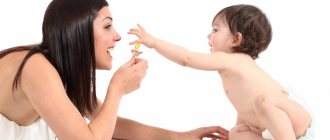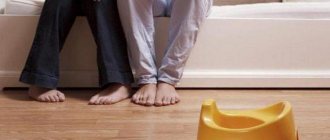Benefits of pacifiers
The first innate reflex of a newborn is sucking, it is thanks to it that the baby must be able to get food for himself and survive in a new world. Often, a pacifier is a lifesaver for new parents. Let's highlight the significant benefits of pacifiers:
- Satisfying the sucking reflex . A child who has satisfied his need for sucking is less susceptible to whims, is able to calm down faster, and falls asleep easier. Usually, weaning from the pacifier begins almost immediately after 1 year, while the reflex lasts on average up to 2.5 years.
- Relief of pain during teething . Sucking not only calms the baby, it acts as a pain reliever and scratches swollen and itchy gums.
- Some speech therapists note that facial muscles trained by a pacifier contribute to the early development of speech , perhaps even earlier than in peers whose parents did not want to give a pacifier.
- The pacifier causes increased salivation , which in turn improves digestion and relieves painful gas.
- Protection against sudden infant death . Newborns and infants sleep in a relaxed state on their backs, arms and legs spread out. The pacifier protects against tongue sinking, which can lead to difficulty breathing, and sometimes even more tragic consequences.
- In winter, the pacifier does not allow the baby to swallow cold air , therefore, the baby is not afraid of inflammation of the tonsils, adenoids and sore throat.
But along with significant advantages, there are also significant disadvantages. And only after carefully weighing all the pros and cons, you can decide whether you need to accustom your child to a pacifier.
How are pacifiers different?
2 month old baby's daily routine
When answering the question of which pacifier to choose for a child, experts advise mothers to pay attention to the shape of the breast nipple, which takes on a certain shape. This will tell you what shape of pacifier is best for your baby.
According to the shape of the sucking part
- The shape of the classic, that is, round, nipple repeats the nipple of the mammary gland. This brings the process as close as possible to natural feeding.
- The orthodontic pacifier has a beveled and flattened shape. This reinforces the correct position of the tongue in the mouth. There are different types on sale: “Cherry” - for newborns with a large palate; “Butterfly” – for sucking while lying on the tummy; “Heart” – for good development of the dentition.
- The anatomical pacifier looks like a flattened oval and evenly distributes pressure on the palate.
- New generations of nipples with an anti-vacuum system have appeared on sale, that is, with a valve that helps reduce the volume of swallowed air, which reduces the frequency of regurgitation. Plus - it prevents sticking, which makes it possible not to tear yourself away from the bottle during feeding.
Important! The pacifier should change with the child’s development and take into account his individual characteristics; the pediatrician’s recommendations will help you choose the right size and material.
When purchasing a pacifier, you should pay attention to its material and size.
Disadvantages of pacifiers
- If the child is breastfed, then the pacifier distracts the baby from the mother's breast , accordingly, the number of attachments decreases, which means milk production decreases, which can provoke early breast refusal.
- If the pacifier is not selected for age or size, it can cause malocclusion , which will lead to dental problems or even speech problems.
- The pacifier can serve as a source of disease if you do not keep it clean. Bacteria and viruses that fall on it penetrate the baby’s intestines.
Should you accustom your child to a pacifier: pros and cons
The sucking reflex is the most important skill that a child needs for survival, as it provides nutrition, and for establishing a strong psycho-emotional connection with the mother.
If the baby is breastfed and sucks on his mother’s breast at the first request, then the sucking instinct is fully satisfied, so he does not need a pacifier. In addition, many natural scientists themselves are beginning to abandon this device.
Another thing is a baby on artificial feeding or a baby who receives mother's milk by the hour. These babies need a pacifier because their need to suckle at the breast is partially or not met at all.
Some physiological experiments have shown that when weaned from the mother's breast, babies' heart rates begin to increase. But if at this moment you offer them a pacifier, the heart contractions will gradually return to normal. This happens because a pacifier relieves stress and suppresses the expression of negative emotions.
Thus, experts, answering the question of why it is necessary to use a pacifier, give the main argument - the child calms down and quickly falls asleep due to the complete satisfaction of the sucking reflex.
Pros of using a pacifier
Stimulating vital unconditional reflexive behavior is not the only benefit of using pacifiers. According to the beliefs of some experts, a pacifier can perform several useful functions, among which are the following:
- assistance in preventing colds during the cold season;
- regulation of feeding schedule;
- prevention of thumb sucking;
- falling asleep faster and prolonging restful sleep;
- reduction of pain during teething;
- prevention of sudden infant death syndrome due to the fact that the tongue does not sink;
- reduction of negative feelings in painful conditions;
- stimulation of the release of gases from the gastrointestinal tract, which helps relieve the child from colic;
- improvement of bite when choosing a special orthodontic attachment.
Many parents note that the use of this hygienic device allows them not to worry about the fact that a baby who has learned to walk will pick up various dirty objects in the sandbox or just on the street and put them in his mouth.
Disadvantages of using a pacifier
It is possible to accustom a baby to a pacifier, but many experts argue against this process, since the benefits of sucking can be outweighed by negative consequences.
Experts attribute the following aspects to the negative aspects of using pacifiers:
- incorrect selection of pacifiers can lead to malocclusion;
- sucking on a hygienic device can provoke the child to refuse the breast, which will ultimately result in a transition to mixed or artificial feeding;
- a child who is accustomed to a pacifier is more likely to be at risk of contracting infectious diseases of the mouth;
- formation of the habit of sucking a pacifier, as a result of which parents have to wean themselves off the pacifier;
- grasping a pacifier with your lips is different from sucking a breast, as a result of which the mother may feel discomfort when feeding the baby;
- inhibits the child’s development, the child’s interest in the world around him decreases.
The question of whether a child needs to be accustomed to a pacifier is decided solely by the parents, based on the recommendations of the pediatrician. A thoughtful and balanced decision will allow you to avoid the negative consequences described above.
Doctor Komarovsky's opinion
TV doctor E.O. Komarovsky, widely known and respected by mothers, is convinced that the positive and negative properties of pacifiers are overly exaggerated. The main principle of their use, according to the pediatrician, is mandatory compliance with hygienic requirements.
However, Komarovsky does not recommend accustoming a child to a pacifier if a woman has certain problems with the volume of milk secretion. The baby, distracted by the pacifier, will have less intense influence on the mother's nipples, which can lead to suppression of lactation.
But another situation should be taken into account - when the child is literally hanging on his mother’s breast, trying to realize his sucking reflex. In this case, a pacifier will allow the mother to free up some time and ensure peace in the house.
At what age should you teach
You can try to connect a baby with a pacifier as early as one month of age, when he cannot yet separate the pacifier and the mother's breast. It’s worth starting with the simplest model – the Soviet “daisy”. As practice shows, among the many fashionable pacifiers, most children choose this one.
If the first acquaintance ended in failure, the baby tried to spit out an incomprehensible object, then postpone this process for a couple of weeks, or even a month, and try again.
If your child categorically refuses a pacifier for 6-7 months, then stop torturing each other, then there is no place for a pacifier in your home.
Useful tips
Under no circumstances should you categorically make your baby addicted to the pacifier by covering it with various sweets, such as jam. An unstable body can react acutely negatively to various sweets. This could result in a severe allergic reaction or scrofula.
Based on the same considerations, it is strictly forbidden to use bitter products in attempts to wean the baby from the pacifier.
It is forbidden to give a pacifier to a child's mouth after licking it. This is due to the fact that the oral cavity of an adult contains a lot of microbes that are harmful to the child’s still fragile body. Which, as a result, is fraught with the occurrence of various infections in the body.
The main thing that parents need to take note is: “Hurry is needed when hunting for fleas,” but in this matter there is definitely no need to rush! Be persistent, but without intrusiveness, systematically try to give your baby various pacifiers. It is possible that the child will choose the option that suits him. But if before the age of six months the attempts remain without results, they should be stopped and such an undertaking should be abandoned.
How to choose the right one
When choosing a pacifier, you should pay attention to three parameters: size, shape, material.
Size. Each nipple has an age marking, they are mainly divided into three groups:
- from birth to 3 months;
- from 3 months to six months;
- over 6 months.
A pacifier selected according to age corresponds to the anatomical structure of the baby’s oral cavity; neglecting these parameters is harmful, even dangerous to health.
Form. Modern industry offers three forms:
- Classical: round nipple, narrow at the base, widening towards the end. The most common option, which can be placed in your mouth on either side. Unfortunately, it is she who can form an incorrect bite.
- Anatomical (orthodontic) – has the shape of an ellipse, flattened on one side, for a better fit to the tongue. Its advantage is that it follows all the curves of the child’s gums, tongue, and palate.
- Symmetrical It has the shape of a drop, flattened on one side and convex on the other, and has a beveled nipple. It is located in the mouth in the same way as the mother's breast.
Material. Latex or silicone.
Products made from latex are soft, heat up in the mouth, but are very short-lived, afraid of sunlight, and quickly lose their shape. Silicone nipples are elastic, hold their shape well and for a long time, can be subjected to boiling, but over time they harden and can even crumble.
Selection rules
Pacifiers for children differ in three main characteristics: shape, size and the material from which it is made. In pharmacies you can find nipples made of latex and silicone. What kind of material the baby chooses depends on his personal preferences.
You can offer a newborn baby a latex pacifier - latex is softer than silicone, so the smallest babies get used to it better and faster. For older children, silicone pacifiers are suitable: they are more pleasant to suck on, and silicone is stronger than latex. What is important during the eruption of the first teeth.
With the size, everything is simple: you need to pay attention to the product labeling: 0-3, 3-6, 6-12. But here, too, the tastes and characteristics of the child should be taken into account. If a baby at 4 months refuses a pacifier marked 3-6, you can leave the pacifier that he sucked before, even if it is not suitable for his age.
All information on the packaging is approximate. The final factor in making a decision should be the choice of the baby and his needs.
The shape of nipples can be:
- anatomical (repeats the outlines of the female nipple);
- orthodontic (prevents bite pathologies);
- with an elongated nipple;
- with a voluminous nipple.
The final decision always remains with the child. Parents will have to try several products of different shapes and sizes before the baby decides on what he likes.
Some rules for choosing a pacifier for newborns are described in this video.
When to use a pacifier
You need to give your child a pacifier if he is in a stressful situation - a car ride, a doctor's examination, a long walk or getting dressed/undressed.
The pacifier helps the baby relax and calm down, and can be used before bed.
Instead of rocking your baby in your arms or on a fitball, or lying down in an uncomfortable position for breastfeeding, cover your baby with a blanket, give him a pacifier and pat him on the back - sleep will not take long to come.
At two months of age, when it’s time for colic, a pacifier will also come in handy. When sucking it, saliva is produced, which has a beneficial effect on the digestive system and intestinal motility, which means that the passage of gases is easier and the tummy stops bothering the baby.
If you notice that your baby or toddler constantly sucks on his fist, then it is better to give him or her a pacifier, it will be much more hygienic, and then it will be easier to remove the pacifier from the mouth than a fist or finger.
When is the use of a pacifier necessary?
The truth of life is that you cannot use a pacifier all the time.
Let us list the situations in which the pacifier is a helper and friend:
- Sucking in an infant is a reflex that relaxes and allows you to calm down. Sucking helps you fall asleep easily and quickly. Its use before bed is more than rational.
- The procedure of dressing, as a rule, does not bring pleasure to any child; this procedure before a walk causes hysterics. Here the pacifier again acts as a lifesaver; besides, it will not be superfluous during a walk.
- Sometimes a young mother needs to visit a hospital or other institutions; queues there are the norm, and a long wait will irritate even the most patient baby; take a pacifier with you, it will help in this situation too.
- Exhaustive trips and travel are cases when using a pacifier will be the right solution.
Training methods
If your child, for some reason known only to him, does not take a pacifier, you can use a trick. We offer you some of the most successful life hacks on how to accustom your baby to a pacifier:
- To begin with, you should try different shapes and different materials . Perhaps your picky person will still like something. In this video, a dad talks about how he used this method to accustom his child to a pacifier, who did not want to take it at all.
- Depending on the type of feeding, lubricate the nipple with milk or formula . The familiar taste will not leave the baby indifferent. If the type of food is artificial, then choose a nipple like the one on the bottle.
Important! Do not give in to the advice of grandmothers, do not use honey, jam or other sweets as “bait”! This is dangerous for the child's health! This causes not only allergic reactions, but also diathesis, provokes the occurrence of caries and intestinal disorders!
- At the very end of feeding, carefully replace the breast or bottle with a pacifier ; perhaps a well-fed and satisfied baby will not notice the change.
This method will be especially effective before bedtime. - The last moment when a child can be accustomed to a pacifier is the eruption of the first teeth. It can be offered instead of silicone and rubber teethers . This way, the child will be able to scratch itchy gums, satisfy the sucking reflex, and perhaps even calm down on his own.
Helpful advice! Give your baby the opportunity to learn how to use the pacifier on his own. Forcing a child to do something against his will is a fiasco. Let him just play with her at first. If you are afraid that the pacifier may fall and get dirty, then attach it to a special holder.
Sometimes getting used to a pacifier can be much easier than weaning it off later, so a pacifier should become a lifesaver in emergencies, and not a permanent guest in a small mouth.
As mentioned above, it will be a good helper when falling asleep. The only thing worth considering is that when the baby is immersed in a deep sleep phase, the pacifier must be pulled out. This will have to be done during daytime and night sleep, as well as while walking. Otherwise, a negative association with sleep may arise, and when the pacifier falls off, the baby will wake up and cry.
If after feeding your baby continues to be capricious, but you are sure that he is full and the required portion of milk has been drunk, then offer a pacifier. But not for long, 15 minutes will be enough .
Advice to parents! Don’t offer your little whimsical a pacifier for every complaint he makes. Try to distract him first: rock him, sing a song, look out the window with him or leaf through a book, go for a walk.
If none of the distracting maneuvers bring any benefit, then let the pacifier become a life-saving measure.
Methods to help you get used to the pacifier
Method 1
Hold the baby in your arms in the position that the mother most often uses for feeding. You should stroke the baby with one hand and talk to him affectionately.
Instead of the breast, place a pacifier in the baby's mouth, gently pressing on it with your finger so that the pacifier does not end up on the floor. If the child resists, there is no need to insist. It is better to postpone training for a few days.
Important! You can use this method if the child is not hungry. Otherwise, you can achieve the opposite result.
Method 2
Lubricate the pacifier with something sweet. Grandmothers often advise applying a little honey to the tip of the pacifier. This should not be done, since beekeeping products have high allergenic properties. It is better to use a glucose solution or sweetened water.
Children love sweets, so this method can be quite effective.
Method 3
Some mothers manage to outwit the little picky child by lubricating the nipple with breast milk (or the formula that the child eats). The familiar taste will help speed up the habituation to the pacifier, and will make this process comfortable and painless.
Method 4
It is best to accustom the baby to the pacifier in a horizontal position, immediately after feeding. If a child spits out a pacifier, you can place a cushion to prevent the pacifier from falling out of the mouth. Some children fall asleep with a pacifier after several such training sessions.
Method 5
If the baby gets something to drink, you can feed him not from a spoon, but from a bottle. After the baby has mastered the bottle, pacifier training occurs in 2-3 days.
Why doesn't a child take a pacifier?
There are several reasons for giving up a pacifier. They are simple, quite understandable, and easy to fix.
- Wrong size . As already mentioned, each pacifier is marked with the age for which it is designed. Don't neglect this information. Perhaps the pacifier is too big and is simply falling out of the mouth.
- "Tasteless" material . Some babies prefer soft, warm latex nipples, while others prefer elastic, hard silicone ones. Try both options, then you will understand which is preferable for your child.
- Inconvenient shape . This is where some parents have to collect a whole collection of different forms before finding the one they need.
Advantages and disadvantages of pacifiers
All young parents sooner or later face the question of whether it is worth accustoming their child to a pacifier or can they do without this useful item? Of course, you can do without it, but often a pacifier makes life much easier not only for the little one, but for his mom and dad.
What are the pros and cons of this device? Having studied them in detail, parents will be able to decide whether their child needs a pacifier or not.
Pros of pacifiers
The advantages of pacifiers include:
- A quick way to calm a baby - a pacifier is a quick way to calm a toddler when the mother is not able to breastfeed him or use other methods. The pacifier will be useful on a walk, when visiting a clinic or while visiting;
- Protection against viral infections - in the winter, using a pacifier will protect your baby from colds if he decides to cry or scream while swallowing cold air;
- Protection against bacteria - a pacifier is much cleaner than your hands and surrounding objects. From the age of three months, the baby begins to put into his mouth everything that comes to hand. This behavior is explained by the child’s desire to explore the world around him, and a little later the baby will begin to put fists and toys in his mouth to scratch his gums, which create discomfort for him due to teething;
- Satisfying the sucking instinct - the pacifier is convenient to use before feedings, since with its help the little one can satisfy his instincts. In addition, in the future it will be much easier to wean a child off a pacifier than from finger or fist sucking;
- Reducing discomfort from colic - using a pacifier has a positive effect on the functioning of the baby’s gastrointestinal tract and reduces the intensity of colic;
- Peaceful sleep - with a pacifier, the child will sleep longer and more peacefully;
Cons of pacifiers
However, using a pacifier also has its disadvantages, presented by:
- Fixation on the sucking instinct - from constant sucking on the pacifier, the baby can become passive. He will be less interested in what is happening around him, not trying to study everything and try it out, since one of the most important children's senses (the mouth) is already occupied by the pacifier;
- Possible occurrence of speech defects and malocclusion - such defects appear only if the toddler sucks the pacifier for a long time. If you wean him off it in time, no consequences will arise;
- Reluctance to breastfeed - Constantly sucking on a pacifier in some babies makes them lazy to breastfeed. If this happens, you should not immediately switch the baby to mixed or artificial feeding, as this may negatively affect the child’s health. It is enough to give your toddler a pacifier less, reducing its use to a minimum. However, it is worth considering the fact that such a side effect from a pacifier occurs in isolated cases.
As you can see, the advantages of using a pacifier are much greater than the disadvantages, and therefore you can fearlessly accustom your baby to this useful children's gadget.
If your baby spits out the pacifier
Most often, newborns spit out the pacifier if they have an incorrect bite or a high palate; in this case, you need to contact your pediatrician and dentist so that specialists can help you choose the right option for your child.
The second, most common case, when the child is breastfed, all substitutes for the mother's breast lose greatly. Don't despair, choose the softest nipple, warm it up in hot water for the first time, then you won't notice much of a difference, and you'll soon achieve results.
Dr. Komarovsky's opinion: Evgeniy Olegovich believes that the pacifier was invented in order to solve some parental problems, for example, not training your hearing by listening to the loud howls of a two-month-old baby, who is forced to suck on rattles instead of a comfortable pacifier.
But he reasonably adds that if the pacifier itself turns into a problem, then it should be eliminated immediately. Each child has the right to decide for himself whether he needs this item or not.
Breastfeeding experts unanimously say that a baby does not need a pacifier at all. She just gets in the way. If you definitely want to introduce your baby to a rubber breast substitute, then you should do this only after lactation is completely established. To support this, experts cite the following arguments:
- The baby, although he has a strong sucking reflex, is not able to quickly change technique; the breast and pacifier require different grips. If a child tries the pacifier, he may completely give up breastfeeding, as this is a more labor-intensive process.
- Rare breastfeeding at an early stage can cause lactostasis; in severe forms, it is dangerous due to the formation of inflammation and mastitis.
- If a baby rarely takes the breast, milk production decreases, which can lead to malnutrition, weight loss and even dehydration, since foremilk is 80% water.
How to train?
So, the pacifier that suits the baby has been selected. All that remains is to accustom the child to sucking a pacifier. You should put the baby in the position in which he is used to taking milk or formula, and then carefully place the pacifier in his mouth. For the first few minutes, you can hold it with your hand so that the baby understands what he needs to do.
A little secret - you can try to let the baby get acquainted with the pacifier at the moment when he began to be capricious. Often it is possible to kill two birds with one stone - both to calm the baby and to teach him to suck a pacifier.
When the child has already learned, you should control the time during which he holds his new “toy” in his mouth. To do this, parents are advised to hide the pacifier at the moment when the awake baby spits it out and forgets it for a while. When the baby falls asleep, it is also better to remove the pacifier from his crib.
It is important not to use this item as the easiest way to solve problems. That is, you should not immediately put a pacifier in his mouth as soon as the baby starts crying. This can cause serious psychological trauma to the child. First, you need to try to calm him down using other methods - most often, maternal warmth and affection help to cope with crying and whims.











